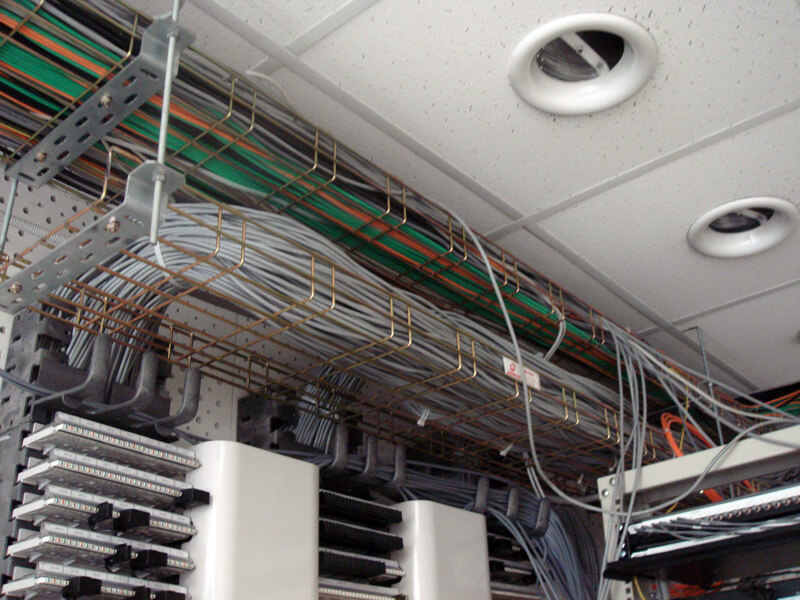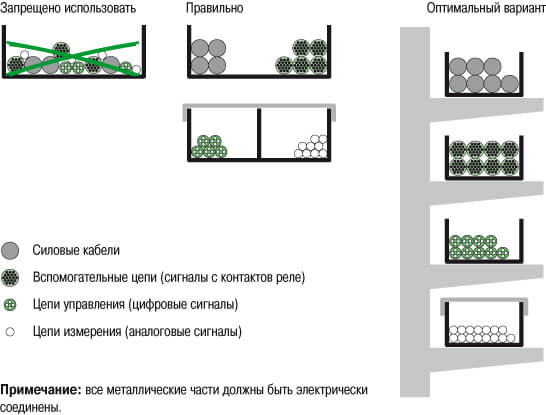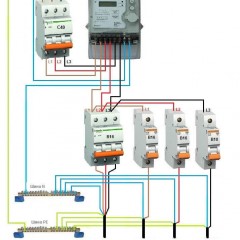How to lay power and low-current cables
Joint Installation Requirements
When considering the issue of joint laying of cables for various purposes, the required documentation and instructions are not always available. Manufacturers of equipment give norms regarding the correct wiring of the required circuits, but in this case recommendations are given regarding the installation of circuits of one device or item of equipment. That is, it does not take into account that during the installation of a large number of equipment, complex systems, certain electrical wiring interact differently.
Therefore, if it is necessary to carry out technical re-equipment, which provides for the replacement of various circuits, in addition to the recommendations of manufacturers, one should take into account the experience of joint operation of networks for various purposes. That is, if in an electrical installation, the equipment and the cable wiring connecting it functioned correctly for several decades, without interference, then when replacing the wiring, it is necessary to observe the old requirements for the mutual laying of circuits of different voltages.
But in this case, it should be borne in mind that if the type of equipment, various devices and systems changes, other types of cables are used, then the old rules will be irrelevant, since with a complete reconstruction of the object, in fact, a new system is created. In this case, it is necessary to focus on the requirements that are given below.
In one pipe, bundle of wires, cable channel, it is allowed to lay together power and low-current cables for various purposes: control, protection, alarm, measurement and other voltages up to 440 V, both alternating and direct current, with the exception of:
- circuits from several independent power supplies that provide mutual redundancy;
- secondary switching circuits relay protection and automation, circuits of metering devices and measuring devices, which may cause mutual interference exceeding the permissible values and which will interfere with the normal operation of these devices;
- low-voltage wiring up to 42 V, which are laid in order to ensure safety in relation to electric shock;
- fire alarm and automation circuits.
If necessary, joint laying of power and low-current cables in an open way, in cable channels, in the tray, etc.The following recommendations should be followed:
- When unilaterally laying cable lines, it is necessary to separate power and low-current cables with asbestos partitions, which are characterized by sufficient fire resistance. At the same time, power cables should be located on top of low-current ones. If low-current networks reserve each other, then they must also be separated by partitions or, if possible, laid in different channels, on different shelves, etc.
- Parallel laying of power (voltage class up to 1000 V) and low-current (for example, control) cables on different shelves or in different compartments is allowed, but provided that this does not violate safety requirements.
- With a two-way method, the wiring is divided: on one side, power, on the other - low-current, as shown in the diagram below.
- The minimum distance between horizontal structures with cables must be at least 100 mm.
In the event that it is not possible or impossible to determine the mutual influence of certain chains, then they should be laid separately. As a rule, during the first months of operation of the installed equipment and devices, it is possible to detect all errors, eliminate them, and ultimately achieve the most optimal joint installation of networks for various purposes.
Also, for a more detailed study of the issue, we recommend that you study the chapter 2.1. PUE Sec. 2.1.15 and 2.1.16, as well as chapter 2.3. clauses 2.3.122-2.3.133 on laying cable lines in cable structures
Mounting Methods
In electrical installations, cable lines are laid in various ways, depending on local conditions.
Outside the premises, cable lines are laid, as a rule, in cable channels and galleries of underground and elevated types, made of reinforced concrete slabs, trays. To supply cable lines from the cable channel directly to the equipment element, metal boxes are used or corrugated pipes with fittings providing sufficient protection against negative environmental factors.
Depending on the location of the installation and the requirements for accessibility, mechanical protection, fire safety and other factors, cable lines can be laid in pipes, wells, in the ground in a trench, tunnels.
Indoors, cables can be laid jointly in cable channels provided for in building structures, behind a suspended ceiling, in metal and plastic ducts, pipes of various types or open on walls and other structures, if this does not contradict the requirements PUE. Depending on the relative position of the clamp cabinets, equipment elements and various devices, the chains between them can be laid both with cables and wires in the boxes.
For the convenience of wiring and saving space in cable ducts, trunk cables with a large number of cores are used, combining chains of different purposes that can be laid together.
Depending on the distance between the cabinets of the clamp assemblies, the chains between them can be laid with cables or wires in the boxes.
More details about the installation of electrical wiring can be found in section 13 of the normative document GOST R IEC 60204-1-2007.
So we examined how the joint laying of power and low-current cables can be performed. We hope the information provided was useful to you!
We also recommend reading:











Do not lay power cables in a bundle!
Heat does not dissipate - overheating with all that it implies - see PUE.
PUE does not agree with you.
2.1.60.On trays, supporting surfaces, cables, strings, strips and other supporting structures, it is allowed to lay wires and cables close to each other in bundles (groups) of various shapes (for example, round, rectangular in several layers).
2.1.62. Permissible continuous currents to wires and cables laid by bundles (groups) or multilayer should be taken into account reducing coefficients, taking into account the number and location of conductors (cores) in the bundle, the number and relative position of bundles (layers), as well as the presence of unloaded conductors.
A bunch of cables can be laid!
2.3.124. The laying of control cables is allowed in bundles on trays and multilayer in metal boxes under the following conditions:
1. The outer diameter of the cable bundle should be no more than 100 mm.
2. The height of the layers in one box should not exceed 150 mm.
3. In bundles and multilayer only cables with the same type of sheaths should be laid.
4. Fastening of cables in bundles, multilayer in boxes, cable bundles to trays should be done so that the deformation of the cable sheaths under the influence of its own weight and fastening devices is prevented.
5. For fire safety purposes, fire protection belts should be installed inside the ducts: in vertical sections - at a distance of no more than 20 m, as well as when passing through the ceiling; in horizontal sections - when passing through partitions.
6. In each direction of the cable route, a margin of at least 15% of the total capacity of the ducts should be provided.
Laying power cables in bundles and multilayer is not allowed.